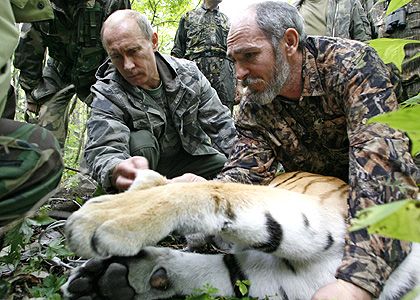
In the forests of the night,
What immortal hand or eye
Could frame thy fearful symmetry?
h/t watertiger @ Dependable Renegade
Yaaaay . . . um, Putin?
Leaders to Convene on Tiger Rescue
By John Rudolph Collins
With just 3,200 tigers thought to remain in the wild, time is growing short to save the species. Poaching and habitat destruction continue to imperil the tiger, which has undergone an estimated 40 percent drop in its wild population over the last decade and is now perched on the brink of extinction throughout much of its range.
Next month, however, officials from the remaining countries with wild tigers will gather in St. Petersburg, Russia, for a major conference on how to reverse the decline of the species. A draft declaration for the summit sets a goal of doubling the wild tiger population by 2022, and conservationists and biologists have high hopes for the gathering.
The summit conference “promises to be the most significant meeting ever held to discuss the fate of a single non-human species,” a group of tiger experts declared in September, in the preface of a major new report charting the tiger’s perilous condition.
Prime Minister Vladimir V. Putin of Russia has already agreed to attend the event and has been a critical force behind its development. His presence is expected to draw numerous heads of state and high-level delegations from the 13 “tiger range” nations.
Look at the size of these paws

The Tiger Summit, to be hosted by Prime Minister Vladimir Putin in Russia in November 2010-the Chinese Year of the Tiger and the International Year of Biodiversity-promises to be the most significant meeting ever held to discuss the fate of a single non-human species. The Summit will culminate efforts by the Global Tiger Initiative (GTI), launched in 2008 by Robert Zoellick, World Bank President. Leaders of 13 tiger range states, supported by international donors and conservationists attending the summit, are being asked to commit to substantive measures to prevent the unthinkable: extinction of the world’s last wild tiger populations.
Wild tiger numbers are at an historic low. There is no evidence of breeding populations of tigers in Cambodia, China, Vietnam, and DPR Korea. Current approaches to tiger conservation are not slowing the decline in tiger numbers, which has continued unabated over the last two decades. While the scale of the challenge is enormous, we submit that the complexity of effective implementation is not: commitments should shift to focus on protecting tigers at spatially well-defined priority sites, supported by proven best practices of law enforcement, wildlife management, and scientific monitoring. Conflict with local people needs to be mitigated. We argue that such a shift in emphasis would reverse the decline of wild tigers and do so in a rapid and cost-efficient manner.


1 comments
Author
Lets keep Tigger from being the only one.